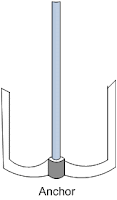 Propeller agitators are commonly made of three-bladed attached to the main shaft. They are flexible in operations and mostly used in the mechanical mixing of low to medium viscosity fluids. These type of propellers are also called as marine type propellers. The diameter of the propellers depends on the rotational speed and diameter of the batch reactor or the agitator vessel. Depending on the agitator vessel size and the fluid viscosity the power consumption of the propeller agitator may exceed more than 50kW.
Propeller agitators are commonly made of three-bladed attached to the main shaft. They are flexible in operations and mostly used in the mechanical mixing of low to medium viscosity fluids. These type of propellers are also called as marine type propellers. The diameter of the propellers depends on the rotational speed and diameter of the batch reactor or the agitator vessel. Depending on the agitator vessel size and the fluid viscosity the power consumption of the propeller agitator may exceed more than 50kW. 
 Turbine impellers operate at low speed and are much larger than propellers. Turbine has an excellent feature in designing the flow pattern where a change in design can divert the flow pattern of fluid by radial flow or axial flow in the reactor vessel. Based on the configuration of the impeller blades these flow patterns can be achieved. The radial design makes the fluid to flow at high velocity in radial direction whereas axial impellers use pitched blades, make the fluid to flow parallel to shaft in the downward direction and then push the fluid towards the wall of the agitator vessel. For gas dispersion operation radial turbine impeller is used and axial turbine impeller is used for chemical reactions, suspension solid and miscible liquid mixing.
Turbine impellers operate at low speed and are much larger than propellers. Turbine has an excellent feature in designing the flow pattern where a change in design can divert the flow pattern of fluid by radial flow or axial flow in the reactor vessel. Based on the configuration of the impeller blades these flow patterns can be achieved. The radial design makes the fluid to flow at high velocity in radial direction whereas axial impellers use pitched blades, make the fluid to flow parallel to shaft in the downward direction and then push the fluid towards the wall of the agitator vessel. For gas dispersion operation radial turbine impeller is used and axial turbine impeller is used for chemical reactions, suspension solid and miscible liquid mixing. Types of agitators models, application and comparison:
| Agitator models | Application | Advantages | Disadvantages |
Paddle:
|
|
|
|
| Counter-rotating paddles | Paste mixing |
|
|
| Tumbling | Blending | Paste and viscous material mixing | Not suitable for fluid solutions |
| Disk and cone | Polymers and dispersion preparation | Viscous solution mixing with 60 revolutions per second | Paste mass cannot be handled |
| Free shaft suspension | Sugar processing | Suspension, Thickening operation | High power requirement |
| Impeller type | Emulsion preparations |
|
Not for viscous materials |
Turbine agitator
|
Liquid and gas reactions |
|
Only for less viscous liquid below 15 to 20 Ns/m2 |
Slotted rotary
|
Powders and cosmetics |
Unique particle size and homogeny product formation |
|
Screw
|
Food and snack processing | Homogenization of high viscous materials | Not suitable for miscibility operations |
Helical
|
Polymer and paints processing | Handles viscoelastic liquids that are more than 20 Ns/m2 | Less radial flow patterns |
| Gate | Blending operations |
|
Not suitable for gas to liquid operations |
Anchor
|
Milk and fat processing | Efficient heat exchange between the reactor walls and reaction mass (fluids) |
|
| Propeller |
|
|
|
